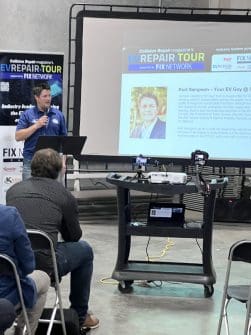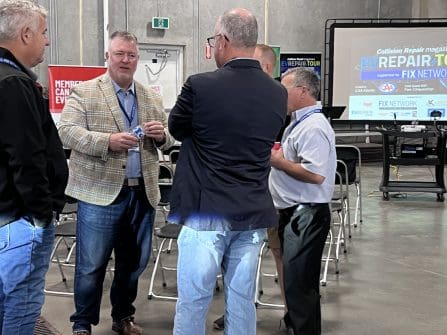Halifax, Nova Scotia — The Collision Repair magazine EV Repair Tour, supported by Fix Network, stopped in Halifax, Nova Scotia, on Wednesday, where collision repair shop personnel, insurance adjusters, OEMs and other industry stakeholders gathered to witness EV experts speak on the intricacies of high-voltage vehicle repair.
Gloria Mann, vice president of industry relations for Media Matters, welcomed attendees to the first-ever EV Repair Tour in Atlantic Canada. Phillippe-Andre Bisson from Fix Network, the key sponsor of the EV Repair Tour, also expressed his gratitude to attendees.
ICE vs. EV—not so different after all
Kurt Sampson of CAA Atlantic was first on the mic. As CAA Atlantic’s “EV Guy”, Sampson drives a Tesla Model S with 500,000 kilometres on the odometer. Previously, he owned a Nissan Leaf and electric Kia Soul.
“I’m very familiar with EVs and driving EVs. And a lot of EV maintenance is the same as you would do on a regular car,” explained Sampson, adding that he replaced his brakes and control arms in his driveway.
David Giles, EV education product specialist for Consulab and president of PoweredEV Training and Consulting, delivered his signature fast-paced crash course in high voltage technologies, stressing, like Sampson, that EVs and ICE vehicles aren’t so different after all.
“Batteries have packs,” explained Giles. “Inside the pack are modules; inside the modules are cells. When we’re rebuilding a battery pack, we’re actually rebuilding battery packs with cells.”
Giles said he purchased a Tesla Model 3 with a “bad battery.”
“I took another battery from a car that was still good and replaced the bad battery,” he said. “It took less than an hour and a half to do it, and that EV was back on the road.”
He added that EV batteries typically outlast the vehicles they’re housed in, to an average of 600,000 kilometres.
“I had a gentleman from Saint John call me up yesterday and said his EV battery is perfect, but the bodywork to restore his car isn’t worth it.”
Giles also stressed that EV-keen repairers need to understand high voltage terminology. Loss of isolation, high voltage interlock loop, ICE, kilowatt, kilowatt-hour, state of health—all terms that are critical in understanding the state of an EV.
Finally, Giles warned the industry that EVs aren’t the only massive shift threatening challenging repairs—advanced driver assistance systems are just as tricky and critical to understand if you want to perform modern collision repairs.
“ADAS, camera calibration systems are also significantly impacting repairs—but we’re here to talk about EVs today.”
“Electrification is not a threat. It is an opportunity.”
“As a collision repair facility, turning away EV business is “silly,” said Giles.
“You’ll wind up without business if you choose not to pursue electric vehicle technology.”
Safety is everything
Bang! An EV is in a collision. What happens next?
Andrew MacDonald, owner of Maritime Auto Salvage and two Fix Auto locations, said first is rescue and extraction—depending on severity—then vehicle storage, handling procedures and PPE are just a few things to consider.
“All EV collisions are different—you need to take towing considerations, too,” said MacDonald.
Thermal runaway—while rare—can send an EV ablaze at more than 3,000 degrees Fahrenheit for two hours or longer, requiring between 4,000 gallons and 6,000 gallons of water to put out. Storage of damaged EV systems is a paramount consideration.
“If a vehicle catches fire and it’s sitting next to another vehicle, or inside your building, that’s a massive risk.”
MacDonald did specify that EV batteries are rarely penetrated in collisions—about three percent to five percent of the time.
As a recycler, MacDonald must pull the EV battery from the car, should one end up in his yard.
“It’s a real question for us, whether it’s safe on the shelf; where I’m going to store it; how do I ship it if someone buys it? Could it burn my facility down? Maybe.”
MacDonald then delivered some fast facts regarding EV claims. Seventy-eight percent of all EV estimates are less than three years old, he said, and less than one percent of EV claims are total losses. Total losses are typically routed to auction channels, auto recyclers or exporters.
“At the end of the day, I think a lot of these EV parts [received by recyclers] will be sent to recycling to recover the precious metals and valuable parts,” said MacDonald.
Testing time
Brendan Piper, EV engagement specialist for Clean Transportation at Next Ride, provided test drives in a Silverado EV at the event and spoke to consumer perks about EVs.
He elaborated on charging technologies, battery capacities, EV parts and more.
Check out our images from the day below as they come in—and stay tuned for more insights from the event.




















































